Yves here. Ooopsie! The Russian investigation of the Kerch bridge bombing has apparently ascertained that the materials used to make the bomb (I assume the nitrogen fertilizer) was smuggled from Ukraine to Ruse via a grain transport ships that landed in Odessa. Whether true or not (and this seems colorable), the Russians now have a case they can make to allies for the need to take Odessa.
By John Helmer, the longest continuously serving foreign correspondent in Russia, and the only western journalist to direct his own bureau independent of single national or commercial ties. Helmer has also been a professor of political science, and an advisor to government heads in Greece, the United States, and Asia. He is the first and only member of a US presidential administration (Jimmy Carter) to establish himself in Russia. Originally published at Dances with Bears
Two detailed reports appeared in Moscow yesterday describing precisely how the attack on the Crimean Bridge on October 8 was organised and carried out.
The sources appear to be the Federal Security Service (FSB), with supporting evidence from the Ukraine, Romania, Bulgaria, Georgia, and Armenia, including at least five eye-witnesses and participants, plus telephone interceptions.
The politics of this evidence, and the timing of its publication now, are plain. The humanitarian grain export agreement, promoted by United Nations (UN) Secretary-General Antonio Guterres, has been manipulated by the Ukrainians and their NATO allies – excluding Turkey – to conceal weapons shipments for military operations against Russia.
Guterres did the same thing in his conduct of the negotiations to evacuate civilians held hostage the bunkers of the Azovstal complex in Mariupol during the siege of April and May. Guterres lied in his direct talks with Russians officials then. He continued lying to them during the International Atomic Energy Agency (IAEA) negotiations on the Zaporozhye nuclear power plant in September. His public lying led to the unprecedented condemnation of the Secretary-General by the Russian Foreign Ministry on September 30; Guterres was dismissed as “an instrument of propaganda and pressure on member states”.
In the newly reported interpretation of the FSB’s evidence, the shipping links have been exposed between Odessa and the Danube River ports of Romania and Bulgaria, opening for public discussion in Moscow the future of Odessa in the operational planning of the Russian General Staff. This is to be decided by the Stavka before President Vladimir Putin leaves for the G20 summit conference in Bali on November 15-16, at which President Joseph Biden and Vladimir Zelensky will also be present. .
Also obvious is what is missing from these operational reports from the FSB sources. So far there has been no publication of the evidence already gathered by the FSB and military intelligence on the M.O. for coordinating the movement of the truck with its explosive charge on the bridge and its movement in parallel with the fuel train, so that the detonation would coincide and strike the train, magnifying the impact on both road and rail structures.
Reports by Vzglyad analysts, Rafael Fakhrutdinov and Yevgeny Krutikov, follow; they have been translated into English without interpolation, explanation, or comment. Maps and other captioned illustrations have been added to this running text.
HOW THE BOMB WAS TRANSPORTED BY SEA FROM ODESSA
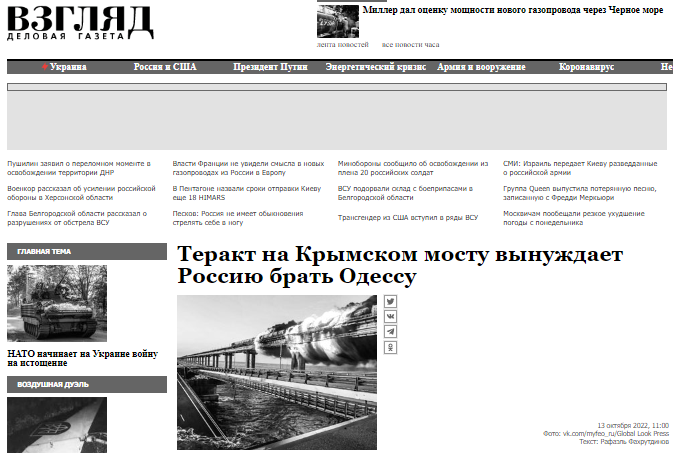
Source:https://vz.ru/
The terrorist attack on the Crimean Bridge forces Russia to take Odessa
The ‘Grain Deal’ helped Kiev organize a terrorist attack against the Crimean bridge
October 13, 2022
By Rafael Fakhrutdinov
The terrorist attack against the Crimean Bridge revealed a serious flaw for Russia’s security in the ‘grain deal’. That provided that vessels carrying grain would be inspected only in the Turkish Straits. The ship carrying explosives which left Odessa was able to safely enter the Danube. This violation of the ‘grain deal’ will not solve the problem – after leaving Zmeiny Island, Russia lost control over this sector of the Black Sea. What are the options?
The Federal Security Service has revealed the organizer and perpetrators of the terrorist attack on the Crimean Bridge – the responsibility has been assigned to the head of military intelligence of Ukraine Kirill Budanov. The FSB has also found out the route of the explosive device which went off on the bridge on October 8.
The first stage of this movement is of particular interest. In early August, the dangerous cargo with a total weight of more than 22 tonnes, camouflaged under rolls of construction film, was transported from the seaport of Odessa along the Black Sea coast and up the Danube to the Bulgarian river port of Ruse, located inland. ‘We see a gross violation of the grain deal. The fact that a military cargo has left Odessa, directed against the Russian Federation, is an obvious violation of the agreement,’ said Deputy Head of the International Affairs Committee of the Federation Council, Andrei Klimov.
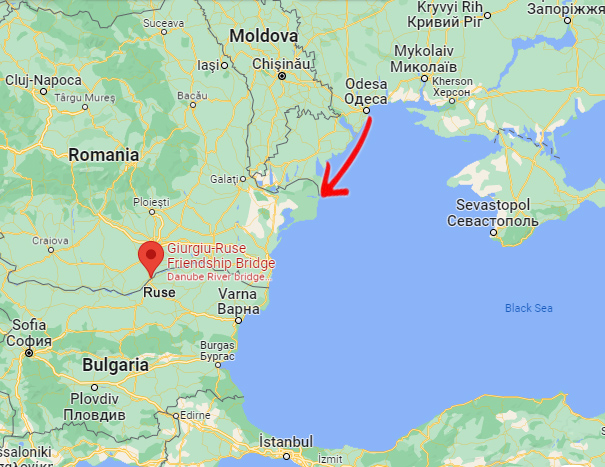
Recall with the inspection of ships in order to exclude the transportation of military cargo. But the subtlety is that the inspection is carried out only at the entrance and exit from the Black Sea. The JCC groups that conduct the inspection are working in harbours in the area of the Turkish Straits of the Bosphorus and the Dardanelles. But the vessel with the explosives ‘turned off’ much earlier.
As the newspaper VZGLYAD has already noted, the ship, which left Odessa for Ruse, moved on a coastal course along the seashore, and then entered the Danube, where it proceeded through Romanian territory to the Bulgarian port. The Ukraine supports active navigation on the Danube, although this is hampered by the Ukrainian mines installed at the beginning of the Special Military Operation near Odessa and [since February 24] have been drifting to the Danube delta.that on July 22 in Istanbul, Russia, Turkey and the UN signed a memorandum of cooperation in the supply of Russian and Ukrainian agricultural products to the markets. Ukraine has signed its part of the agreement with Turkey and the UN. The ‘Grain deal’ was concluded for a period of 120 days until November, with the possibility of extension.
Under the terms of this agreement, a Joint Coordination Center (JCC) with the participation of Russia, Turkey and the Ukraine operates in Istanbul to monitor the departure of ships from Ukraine. The main thing to pay attention to: the JCC is charged
TURKISH NAVY IDENTIFICATION OF UKRAINIAN MINES IN THE BLACK SEA SINCE FEBRUARY
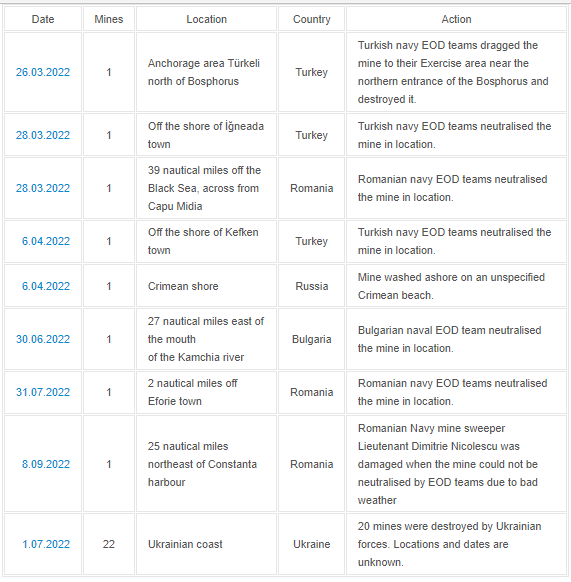
Source: https://turkishnavy.net// -- September 10, 2022
The main thing is that the vessel sailing from Odessa to Ruse was not subject to verification by Turkish observers as part of the ‘grain deal’. ‘We can’t check such vessels that go along the coast. Especially if the ship was sailing under the Bulgarian flag. Two neighbouring NATO countries, Romania and Bulgaria, are exploiting this,’ said military expert Vasily Dandykin.
According to the Istanbul Agreements, ‘all activities in Ukrainian territorial waters are conducted under the authority and responsibility of Ukraine” (point C of the “Initiatives for the safe transportation of grain and food from Ukrainian ports”). The Ukrainian side focuses on this point, which excludes external control. Due to the lack of control, the cargo was delivered to Bulgaria, and from there to Georgia by sea as a transit to Armenia. The cargo was sealed and was not subject to Bulgarian or Georgian customs inspection.
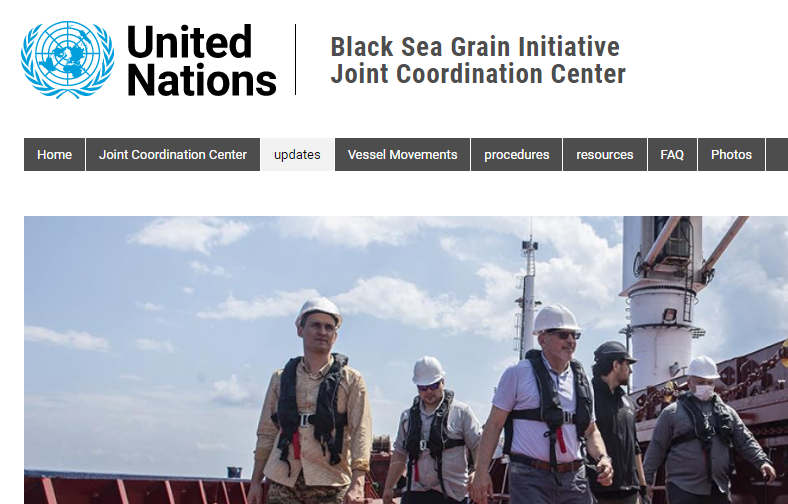
Website of the UN for the implementation of the grain agreement.
Russia did not have the opportunity to control the movement of the vessel along the Black Sea coast from Odessa to the Danube estuary. This is largely due to the terms of the grain agreement. In June, as a gesture of goodwill, Russia withdrew its garrison from Zmeiny Island, which occupies a strategically important position about 35 km east of the mouth of the Danube. From Odessa to Zmeiny is about 120 km, and near the island there is the regular shipping route between the Bulgarian port of Varna and other ports of the western Black Sea region. ‘It has been demonstrated to the world community that the Russian Federation does not hinder the efforts of the UN to organize a humanitarian corridor for the export of agricultural products from the territory of Ukraine,’ RIA Novosti reported the statement by the Russian Defense Ministry regarding the withdrawal of our military from the island. After the evacuation of the garrison from Zmeiny, Ukraine resumed navigation on the Danube.
“The military intelligence agency of Ukraine has clearly calculated – why not take advantage of the situation when the Odessa port is unblocked, and deals continue to be concluded with Bulgaria in the field of construction and so on. What is not a convenient moment? The fact that the ports have been unblocked is being quietly used to carry out such operations,’ Semyon Bagdasarov, director of the Center for the Study of the Middle East and Central Asia, said on the air of Solovyov Live.
Theoretically, Ukrainian military intelligence could well use a cargo ship with grain going towards Istanbul, said Ivan Lizan, head of the analytical bureau of the SONAR-2050 project. ‘The explosives could also have been offloaded [at a concealed location] during the operation by disabling the vessel transponder. After that, turn the transponder on – and the ship would proceed to Istanbul, where representatives of the UN, Russia and Turkey would have boarded it and checked the cargo ship for any prohibited items, including explosives and weapons,’ Lizan said.
Altering the regime of the ‘grain deal’ – for example, so that Turkey (as the guarantor of the Istanbul Agreements) would have the opportunity to inspect ships not in the Bosphorus, but immediately after they leave the Ukrainian ports – would be problematic, says corresponding member of the Academy of Military Sciences, Alexander Bartosh. ‘Can we, within the framework of the grain deal, oblige Turkey to inspect all vessels leaving the territorial waters of Ukraine, and check all ships? I think this would be very difficult – Ankara itself will not agree to this,’ Bartosz told VZGLYAD. ‘Besides, before that, Turkey would have to hold consultations with its NATO allies, and all this would take a very long time.’
“Nevertheless, this should clearly become a topic for negotiations between Russia and Turkey in the very near future. This is because a terrorist attack was committed on Russian territory, in which the Black Sea countries were involved,’ the interlocutor noted.
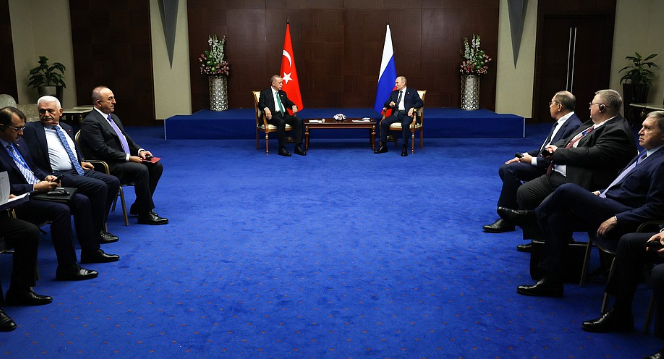
Presidents Putin and Erdogan, with their delegations, meeting in Astana on October 13.
According to Bagdasarov, it is necessary to go further and raise the issue of terminating the ‘grain deal’, the validity period for which, we add, will already expire in November. The expert recalled that Russia has repeatedly criticized the quality of the implementation of these agreements, Vladimir Putin pointed out that the poorest countries, which should be the recipients of supplies, receive from 3% to 5% of all the exported products. ‘A number of countries are interested in this grain deal including Turkey as an intermediary. It is clear that Recep Tayyip Erdogan, in receiving this grain, slightly improves his domestic support rating on the eve of the elections scheduled for next year. Why do we need this grain deal?’ the expert asked himself.
‘The decision to withdraw from the grain deal after the circumstances have been revealed will be made by the leadership of our country. At the same time, it is obvious that the West, represented by the United States, the EU and the UN, has not fulfilled its obligations under the deal,’ said Senator Konstantin Dolgov, former Russian Foreign Ministry Commissioner for Human Rights, Democracy and Rule of Law, and deputy Russian Permanent Representative to the UN.
But if we assume that Russia will withdraw from the deal, then it will be quite difficult to regain control of Zmeiny [Snake] Island and the north-west of the Black Sea as a whole, Bartosh believes. ‘As for the control of the water area in the Zmeiny area, the Russian military may stop some vessel for inspection, but this will be an international scandal, since we do not have an international mandate for such actions. It will also be difficult to take this zone by military means, because it is being shot through by Ukrainian anti–ship warfare means – mobile, disguised,’ the expert points out. ‘They have not been suppressed, and if we could, we probably would have attacked them earlier. In general, the military-political leadership of the Russian Federation will not risk the lives of sailors to try to take control of the waters near this island.’
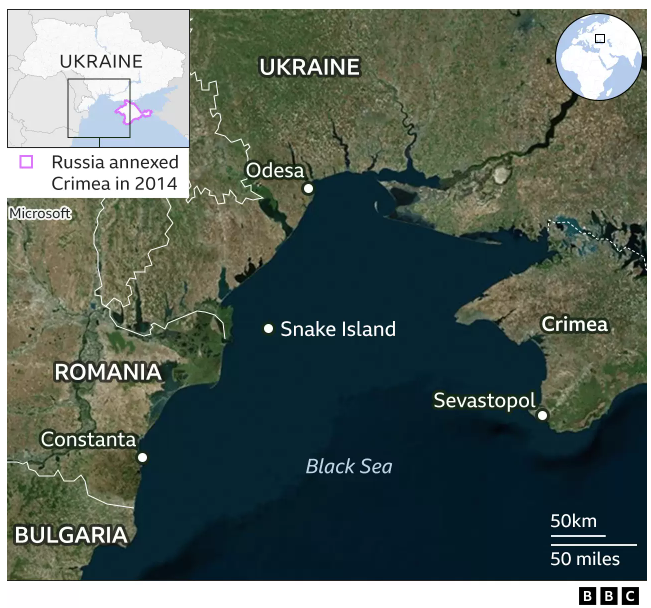
Source: https://www.bbc.com/
‘Cancellation of the Ukrainian grain deal would mean the naval blockade of Odessa and the preparation for its potential assault,’ political scientist and former premier of the Lugansk People’s Republic, Marat Bashirov, noted a few days ago in the Telegram channel. The establishment of control over Odessa as one of the potential targets of the Russian operation is also mentioned by Western experts.
At the end of September, the US publication, National Interest, commented in predicting a possible Russian response to the advance of the Ukrainian Armed Forces in the Kharkov region: ‘Moscow may launch a counteroffensive, focusing on the capture of the Black Sea port of Odessa. This city is the last exit of Ukraine to the Black Sea, and its capture would actually turn the Ukraine into a fully landlocked country. It will also give Russia a stranglehold over Ukraine’s main and vital economic outlet, because most of Kiev’s exports and imports pass through Odessa. The loss of this city would be a colossal economic and psychological blow for Ukraine.’ According to the National Interest, ‘given that Russia has transferred a significant number of troops and weapons from the east of Ukraine to the south, even before Kiev’s offensive in the east,’ there is a high probability that Odessa is now the main target of the Russian Armed Forces.
HOW THE BOMB WAS TRANSPORTED BY ROAD AND TRUCK TO THE BRIDGE
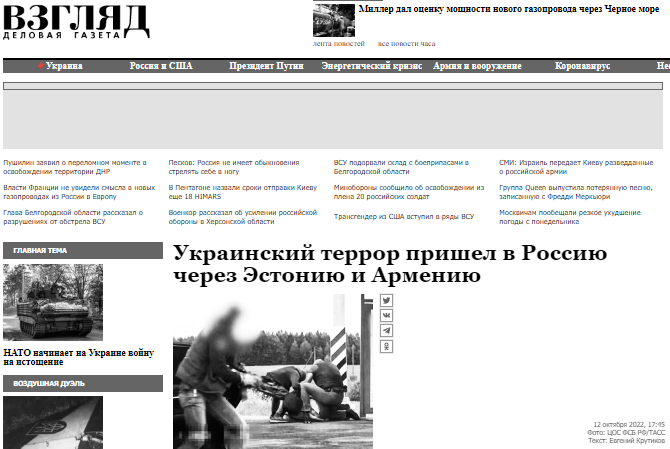
Source: https://vz.ru/
Ukrainian terror came to Russia through Estonia and Armenia
The moment of detention of one of the suspects in the preparation of terrorist attacks on the territory of Russia
October 12, 2022, 17:45
By Evgeny Krutikov
With unusual speed the FSB of Russia has revealed the picture of who delivered the explosives that eventually worked on the Crimean Bridge, and how. A lot of people participated in the covert operation, and it was managed by the military intelligence agency of Ukraine. Why did all this become possible and how did the explosives easily slip over several borders at once, including the Russian one?
The FSB has announced the detention of five citizens of Russia plus three citizens of Ukraine and Armenia as part of the investigation into the terrorist attack on the Crimean Bridge. The organizer of this crime is called the Ukrainian military intelligence. The FSB stated that “the organizer of the terrorist attack on the Crimean Bridge was the Main Intelligence Directorate of the Ministry of Defense of Ukraine, its head Kirill Budanov, employees and agents.”
Also on Wednesday, it was reported about the detention in the Bryansk region of a Ukrainian agent who was going to detonate an explosive device at one of the logistics terminals. Another saboteur was detained in the Moscow region with two portable Igla anti-aircraft complexes. Both of them entered the territory of Russia through Estonia; the weapons and explosives were unearthed in caches in the border regions.
According to the investigation, the explosive device which went off in a truck on the Crimean Bridge was camouflaged in rolls under construction plastic film on 22 pallets with a total weight of 22,770 kg. In early August this was sent from the seaport of Odessa to the Bulgarian city of Ruse under contract No. 02/08/2022 between LLC Translogistic UA (Kiev) and Baltex Capital S.A.
The Bulgarian city of Ruse is located not on the Black Sea, but on the Bulgarian bank of the Danube River in the interior of the country. Consequently, the ship, which left Odessa for Ruse, moved on a coastal course along the seashore, and then entered the Danube. Thus, it was not subject to verification by Turkish observers as part of the ‘grain deal’.
And then the cargo was delivered from Bulgaria to [Poti] Georgia by sea in transit for Armenia. That is, it was sealed and was not subject to Bulgarian or Georgian customs inspection. This is a “gray” scheme, according to which contraband is usually smuggled.
“Citizens of Ukraine Mikhail Vladimirovich Tsyurkalo, born in 1975, Denis Olegovich Kovach, born in 1979, Roman Ivanovich Solomko, born in 1971; citizens of Georgia Inosaridze Sandro, a broker named Levan, and a citizen of Armenia Arthur Terchanyan, born in 1985, were involved in organizing the shipment of cargo from Bulgaria to the port of Poti (Georgia), and then to Armenia. From September 29 to October 3, 2022, in Yerevan, at the Transalliance terminal, the cargo was cleared according to the rules of the EEC and documents were substituted, after which its new dispatcher became GU AR JI GROUP LLC (Republic of Armenia, Alaverdi city), and the recorded consignee became Leader LLC (Moscow city), according to the FSB report.
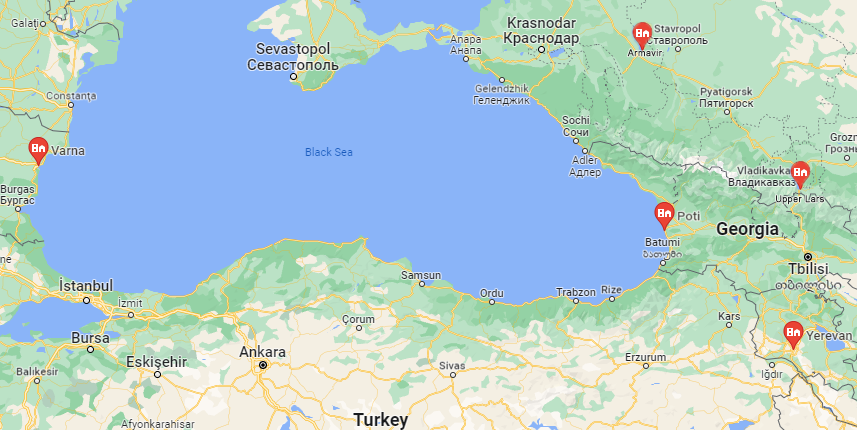
However, the cargo did not reach Moscow. On October 4, the cargo crossed the Russian-Georgian border at the Upper Lars checkpoint on a DAF truck registered in Georgia and was unloaded at the Armavir wholesale base of the Krasnodar Territory on October 6.
It should also be noted here that the cargo had already been customs cleared according to the Eurasian Economic Commission (EEC) rules in Yerevan, and therefore it was not subject to additional customs inspection at the Russian border. By the way, the Georgian side has already managed to disown what had been happening, declaring that ‘no cargo with explosives crossed the Georgian customs border.’ Formally, this is true, since the cargo had already been cleared in Yerevan according to the rules of the EEC, and had nothing to do with the Georgian customs border. To be clear: the customs border is different from the physical one. For transit goods going from one EEC country [Armenia] to another [Russia] through the territory of a country that is not a member of this union [Georgia], it is as if they do not cross the customs space of this transit jurisdiction.
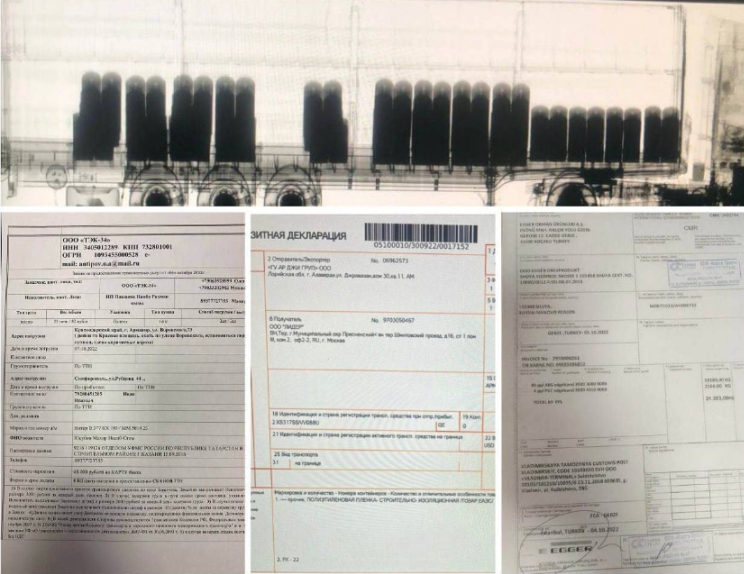
A reproduction photo of the truck cargo and copies of the EEC customs declarations released by the FSB.
In Armavir, the cargo was received by a local company Agro Service, engaged in the cultivation of soybeans. This is a family business, which has been owned by the Azatian family for more than 20 years – the head of the family Samvel and his children — the elder George and the younger Artem. All of them are natives of the city of Makeyevka, Donetsk People’s Republic who moved to Krasnodar Krai a long time ago.
Samvel the father and oldest son George are mainly engaged in the affairs of their soy business. The youngest, Artem, studied to be a lawyer, but he did not find a place for himself in Armavir and some time ago went to live in the Crimea. To Simferopol to work. It was Artem Azatian who called his father from Crimea on the eve of the terrorist attack and asked him to help some friend of his. The friend had asked him to hold a cargo in his warehouse for literally a day, for which another truck would then come from Krasnodar to collect it. The elder brother George was not sleep-walking but he was very surprised when a truck with foreign (Georgian) license plates drove up to his warehouse.
“The driver handed me a stack of invoices to sign, but I gave them back to him. Why should I read and sign other people’s documents? Father and brother agreed, I helped,” he explained. This is a normal story for the North Caucasus.
George Azatian and a company worker, tractor driver Yuri Postnikov, organized the unloading of pallets from the Georgian truck using a forklift. During the investigation, the FSB took Postnikov’s work gloves in which he had worked on the unloading and reloading. Apparently, the investigation hopes to find traces of explosives on them. But this is unlikely. In the evening of the same day, an Inter company truck from Krasnodar stopped by the warehouse, where the pallets were loaded.
Where did the Inter truck come from, which eventually exploded on the Crimean Bridge?
There is an electronic freight exchange in Russia, ATI.SU, created by one IT company. The exchange’s head office is located in St. Petersburg. It has been operating for more than 20 years, it is a respected structure that is used in 60 countries. It works like this. You need to transport cargo from point A to point B. You don’t have your own trucks or other means of delivery. Then you place an ad-request on this exchange with an indication of the route and the desired dates of loading / unloading. You are contacted by independent carriers, of which there are a dime a dozen in the country: people buy a truck (often a truck) or some other cargo vehicle and earn money on it.
You choose the carrier you like and enter into an electronic contract with him. There is a feedback system and reviews about customers and carriers. Very often, this exchange is also used by large regional transport aggregator companies which receive a certain order in a region where at that time they don’t have their own vehicles. A convenient thing.
This system is similar to the one called bareboat charter in seaborne shipping. This is when the customer hires just the vessel without a crew for cargo transportation. Then the captain is hired, and he hires the crew. At the same time, it is only known that it is necessary to transport cargo from point A to point B, but what kind of cargo it is – even the captain does not necessarily know this. And often he doesn’t want to know.
In the case of an electronic transportation exchange, the driver also does not know what he is carrying. That is, in theory, he should know. Because he has the invoices and all other documents, but in reality the driver sees only bags or boxes. Freight forwarders usually do not look into the cargo. Another feature of such a system — carriers often do not deal with the actual manufacturer of the cargo, but with intermediaries or stockists detached from the sale and purchase deal. In our case, such intermediaries unwittingly turned out to be Samvel and Georgy Azatian who had been asked in a fraternal way to hold someone else’s cargo in their wholesale warehouse for a day.
At the height of the bombing of planes by various Palestinian groups in the 1970s and 1980s, airports expressly announced: do not take other people’s belongings or parcels with you on board. At the end of the 1980s and in the 1990s, such memos were already distributed in the USSR, and then in Russia. But how can you refuse a loved one?
And on the eve of the terrorist attack, an offer appeared on this electronic freight exchange from a certain transport company from Ulyanovsk ‘TEK-34’ to transport cargo from Armavir to Simferopol. A non-existent company was indicated as the recipient of the cargo in Crimea. The fact that it does not exist, this turned out much later.
The TEK-34 company was registered in the Volgograd region by a citizen of the Russian Federation Alexey Orlov, but it last showed signs of life in 2018. Then it was bought out in 2020 by Oleg Antipov, a resident of Ulyanovsk, on whose behalf the announcement was placed on the electronic exchange. Antipov has not been detained and is actively cooperating with the investigation. He claims that he was framed and “his conscience is clear.”
And it was like this. “On October 7 of this year, with the assistance of Roman Solomko, a citizen of Ukraine, Vladimir Vasilyevich Zloba, born in 1987, and five other established citizens of Russia, the documents for the cargo were changed again, the sender indicated LLC TEK-34 (Ulyanovsk), and the recipient was a non–existent company in the Republic of Crimea,” the FSB reports.
That is, established hackers hacked the website of the TEK-34 company and placed an ad on the electronic transportation exchange on behalf of Oleg Antipov.
A private carrier Mahir Yusubov, born in 1971, a resident of Krasnodar, responded to the ad. The car, the same “Inter”, was recently re–registered to his own nephew, 25–year-old Samir Yusubov, who is currently abroad.
The fact is that trucker Mahir Yusubov got into an accident somewhere near Kazan some time ago and remained in debt to someone. And out of harm’s way, I re-registered the wet nurse truck to my nephew so that they wouldn’t take it away. Creditors will come – and he has nothing. That is why at first the first suspect was a young Samir Yusubov, although the driver of the truck, 51-year-old Mahir, clearly visible on the video at the checkpoint at the Crimean Bridge, did not even look like a young and athletic Samir in body build. A few days later, Samir Seymour oglu Yusubov officially stated that he had nothing to do with the incident.
The owners of the Armavir warehouse, the Azatian family and trucker Mahir Yusubov, did not contact each other in any way. The Azatians only knew the number of the car that would come to pick up the cargo. Also out of the scheme is a Georgian trucker who delivered cargo to Armavir across the Russian border. Armenian soybean producers, a poor Azerbaijani trucker and a Georgian driver are a whole Caucasian international that was remotely manipulated by Ukrainian military intelligence.
All these eight hours that Mahir Yusubov drove the truck from Armavir towards the Crimea, he was constantly contacted by a Ukrainian intelligence officer who called himself Ivan Ivanovich. For communication, an anonymous electronic number purchased on the Internet was used, as well as a real phone number registered to a citizen of Ukraine, a resident of Kremenchuk, Andreichenko Sergey Vladimirovich, born in 1988.
Most of the people involved in the scheme were used by Ukrainian intelligence in the dark. Nevertheless, the investigation emphasizes that the investigation of the terrorist attack continues, and all its organizers and accomplices, “including foreign citizens, will be brought to justice in accordance with Russian law.”
There is reason to believe that now the greatest interest for the investigation is the same “acquaintance” of Artem Azatian, who “asked in a brotherly way” to hold the cargo in his family’s warehouse in Armavir. Why Ukrainians needed it is clear. A truck with Georgian license plates at the checkpoint at the Crimean Bridge would not just be inspected, but would be disassembled into cogs. Even early on Saturday morning. And here is a local trucker, his own, Krasnodar. For sure, the unfortunate Mahir Yusubov has repeatedly traveled across the bridge to the Crimea before.
The “acquaintance” of Azatian Jr. could well have been formed on the basis of a common origin (recall that the Azatian family came from Donetsk Makeyevka) or a childhood or teenage acquaintance. This method has been used by Ukrainian intelligence for many years. A person is approached by his childhood friends, classmates. Even quite sane people are undermined by such nostalgia.
The Ukrainian scheme used numerous holes not only in the organizational system of transportation, but also in legislation and even in international agreements. The cargo was sent to Bulgaria by the Danube, not by sea. Georgia is a smuggler’s paradise, where all kinds of brokers have been working for years with entrances and exits around the ports of Poti and Batumi. Russian customs and border guards cannot control how goods and cargo are cleared in Yerevan. After the Armenian customs clearance, the goods become free to move throughout the EurAsEC space.
Yes, such operations are costly, since the cargo sailed and traveled for a month. They are risky, because everything could go wrong at any moment. The more people participate in the scheme, especially in the dark, the greater the chance of failure. The tractor driver Postnikov would have made a mistake, working on a loader in a warehouse, if he had dropped the very pallet where the fuse was, and half of Armavir would have blown up.
Another thing is that preliminary intelligence work was carried out. Someone had to find out that Artem Azatian has a dad and an older brother, and they have a warehouse in Armavir. The rest is not so difficult, although it requires clever planning. If we assume that the truck from Yerevan to the Crimean Bridge was remotely controlled by one employee of the Ukrainian special services (the notorious “Ivan Ivanovich”), then everything is quite simple.
It’s this simplicity that scares. Both other Ukrainian terrorists detained on Wednesday crossed the Russian border from Estonia. And the one with the MANPADS drove them in the car. The Estonian border raises questions. It is worth recalling that the citizen of Ukraine Vovk, who is suspected of the murder of Daria Dugina, also fled from the Russian Federation to Estonia.
The detention of a Ukrainian terrorist with anti–aircraft missiles in the Moscow region is a separate story. He wanted to hit something or someone. If we are talking about passenger planes, then this is obviously the preparation of an act of international terrorism. Given the many alarming signals, it can be assumed that there may be more such groups or lone terrorists. They are controlled from a single center (GUR MO of Ukraine) and are dangerous because of their frostbite.
![]() The main method of dealing with them is agent intelligence, as well as unwinding communication chains. And closing the Estonian border or normalizing customs relations are more political than counterintelligence actions.
The main method of dealing with them is agent intelligence, as well as unwinding communication chains. And closing the Estonian border or normalizing customs relations are more political than counterintelligence actions.


